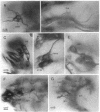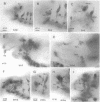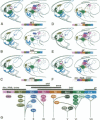Abstract
The development of the insect head tagma involves massive rearrangements and secondary fusions of segment anlagen during embryogenesis. Due to the lack of reliable morphological markers, the number, identity, and sequence of the head segments, particularly in the pregnathal region, are still a matter of ongoing debates. We examined the complex array of internal structures of the embryonic Drosophila melanogaster head such as the sensory structures and nerves of the peripheral and stomatogastric nervous systems, and we used embryonic head mutations causing a lack of overlapping segment anlagen to unravel the segmental identity and the sequence of the neural elements. Our results provide evidence for seven distinct segments in the Drosophila head, each characterized by a specific set of sensory neurons, consistent with the proposal that insects, myriapods, and crustaceans share a monophyletic evolutionary tree from a common annelid-like ancestor.
Full text
PDF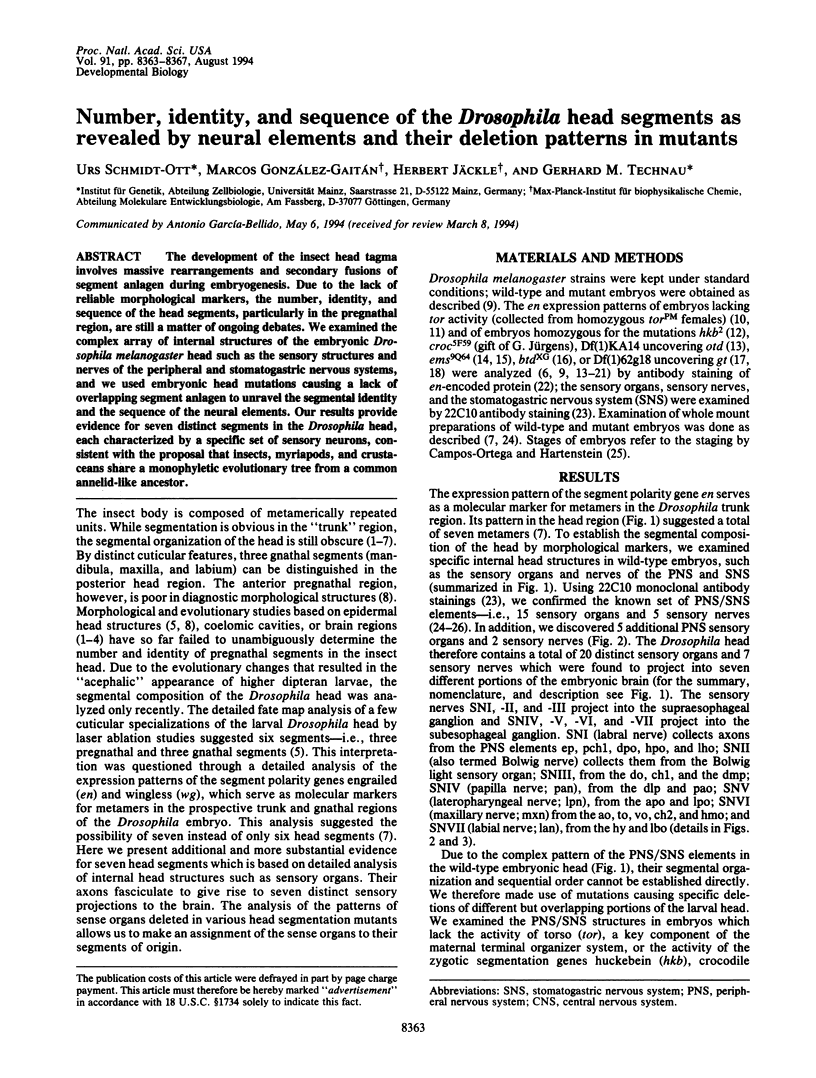
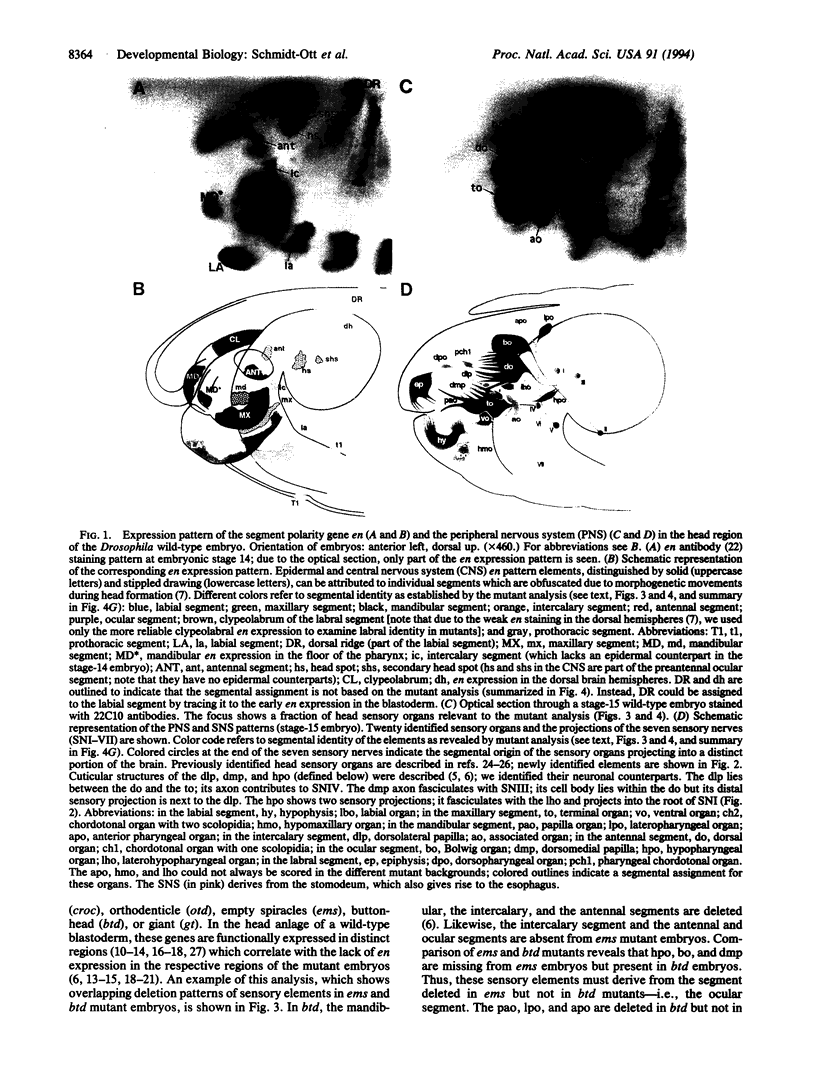
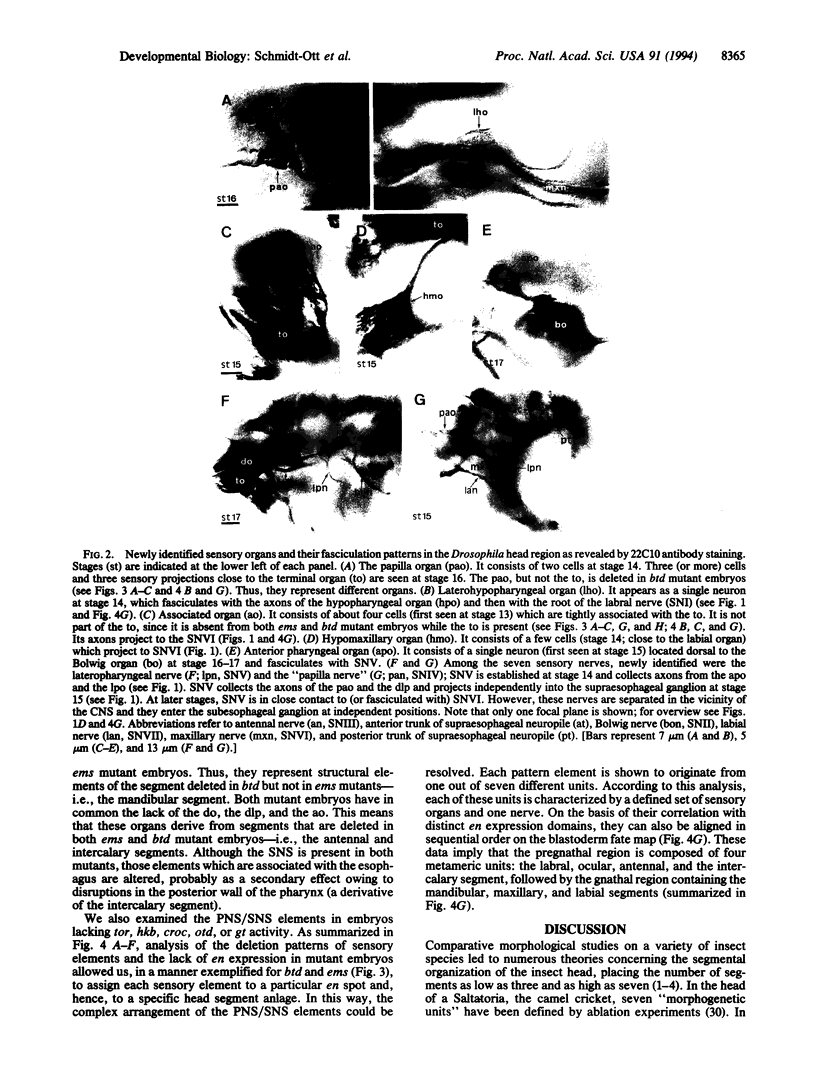
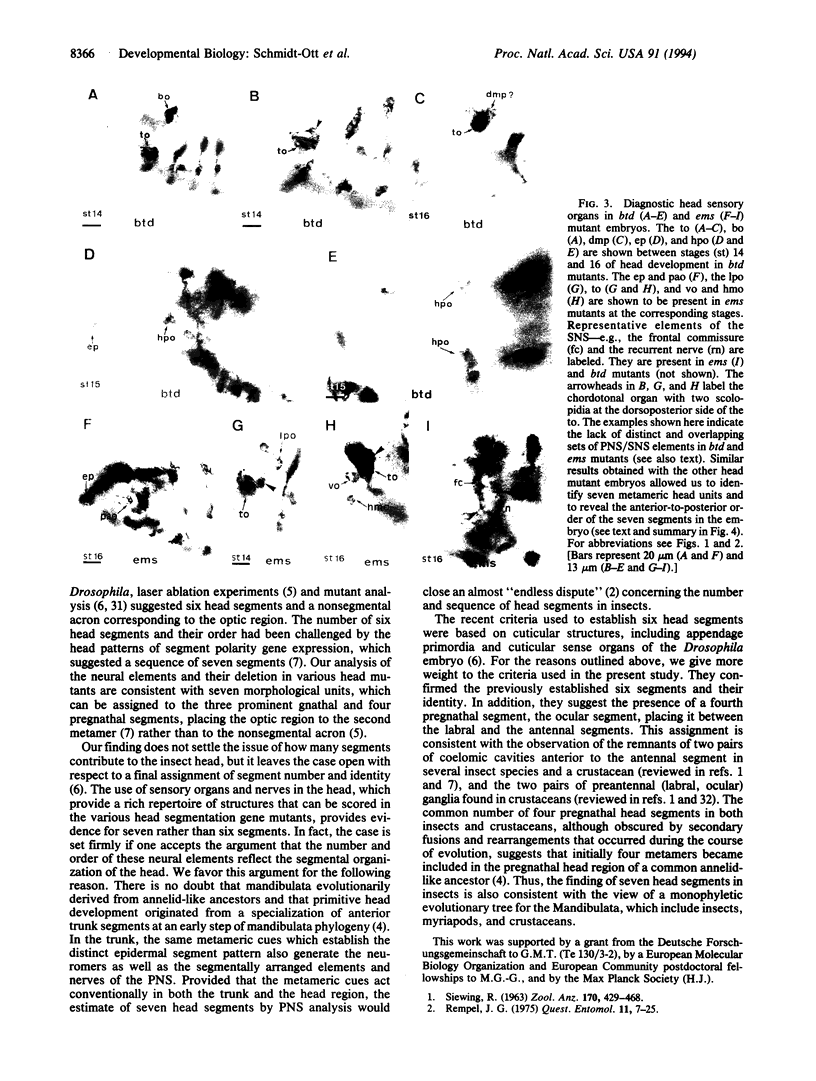
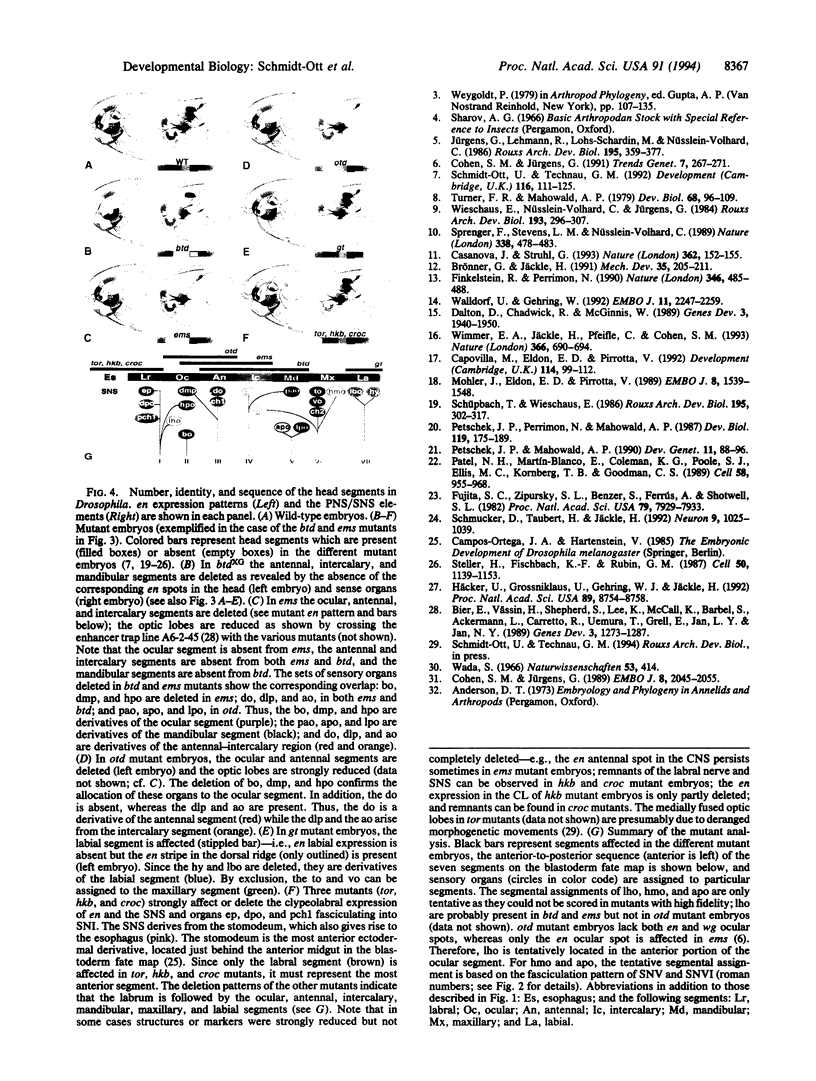
Images in this article
Selected References
These references are in PubMed. This may not be the complete list of references from this article.
- Bier E., Vaessin H., Shepherd S., Lee K., McCall K., Barbel S., Ackerman L., Carretto R., Uemura T., Grell E. Searching for pattern and mutation in the Drosophila genome with a P-lacZ vector. Genes Dev. 1989 Sep;3(9):1273–1287. doi: 10.1101/gad.3.9.1273. [DOI] [PubMed] [Google Scholar]
- Brönner G., Jäckle H. Control and function of terminal gap gene activity in the posterior pole region of the Drosophila embryo. Mech Dev. 1991 Nov;35(3):205–211. doi: 10.1016/0925-4773(91)90019-3. [DOI] [PubMed] [Google Scholar]
- Capovilla M., Eldon E. D., Pirrotta V. The giant gene of Drosophila encodes a b-ZIP DNA-binding protein that regulates the expression of other segmentation gap genes. Development. 1992 Jan;114(1):99–112. doi: 10.1242/dev.114.1.99. [DOI] [PubMed] [Google Scholar]
- Casanova J., Struhl G. The torso receptor localizes as well as transduces the spatial signal specifying terminal body pattern in Drosophila. Nature. 1993 Mar 11;362(6416):152–155. doi: 10.1038/362152a0. [DOI] [PubMed] [Google Scholar]
- Cohen S. M., Jürgens G. Proximal-distal pattern formation in Drosophila: cell autonomous requirement for Distal-less gene activity in limb development. EMBO J. 1989 Jul;8(7):2045–2055. doi: 10.1002/j.1460-2075.1989.tb03613.x. [DOI] [PMC free article] [PubMed] [Google Scholar]
- Cohen S., Jürgens G. Drosophila headlines. Trends Genet. 1991 Aug;7(8):267–272. doi: 10.1016/0168-9525(91)90327-M. [DOI] [PubMed] [Google Scholar]
- Dalton D., Chadwick R., McGinnis W. Expression and embryonic function of empty spiracles: a Drosophila homeo box gene with two patterning functions on the anterior-posterior axis of the embryo. Genes Dev. 1989 Dec;3(12A):1940–1956. doi: 10.1101/gad.3.12a.1940. [DOI] [PubMed] [Google Scholar]
- Finkelstein R., Perrimon N. The orthodenticle gene is regulated by bicoid and torso and specifies Drosophila head development. Nature. 1990 Aug 2;346(6283):485–488. doi: 10.1038/346485a0. [DOI] [PubMed] [Google Scholar]
- Fujita S. C., Zipursky S. L., Benzer S., Ferrús A., Shotwell S. L. Monoclonal antibodies against the Drosophila nervous system. Proc Natl Acad Sci U S A. 1982 Dec;79(24):7929–7933. doi: 10.1073/pnas.79.24.7929. [DOI] [PMC free article] [PubMed] [Google Scholar]
- Häcker U., Grossniklaus U., Gehring W. J., Jäckle H. Developmentally regulated Drosophila gene family encoding the fork head domain. Proc Natl Acad Sci U S A. 1992 Sep 15;89(18):8754–8758. doi: 10.1073/pnas.89.18.8754. [DOI] [PMC free article] [PubMed] [Google Scholar]
- Mohler J., Eldon E. D., Pirrotta V. A novel spatial transcription pattern associated with the segmentation gene, giant, of Drosophila. EMBO J. 1989 May;8(5):1539–1548. doi: 10.1002/j.1460-2075.1989.tb03538.x. [DOI] [PMC free article] [PubMed] [Google Scholar]
- Patel N. H., Martin-Blanco E., Coleman K. G., Poole S. J., Ellis M. C., Kornberg T. B., Goodman C. S. Expression of engrailed proteins in arthropods, annelids, and chordates. Cell. 1989 Sep 8;58(5):955–968. doi: 10.1016/0092-8674(89)90947-1. [DOI] [PubMed] [Google Scholar]
- Petschek J. P., Mahowald A. P. Different requirements for l(1) giant in two embryonic domains of Drosophila melanogaster. Dev Genet. 1990;11(1):88–96. doi: 10.1002/dvg.1020110110. [DOI] [PubMed] [Google Scholar]
- Petschek J. P., Perrimon N., Mahowald A. P. Region-specific defects in l(1)giant embryos of Drosophila melanogaster. Dev Biol. 1987 Jan;119(1):175–189. doi: 10.1016/0012-1606(87)90219-3. [DOI] [PubMed] [Google Scholar]
- Schmidt-Ott U., Technau G. M. Expression of en and wg in the embryonic head and brain of Drosophila indicates a refolded band of seven segment remnants. Development. 1992 Sep;116(1):111–125. doi: 10.1242/dev.116.1.111. [DOI] [PubMed] [Google Scholar]
- Schmucker D., Taubert H., Jäckle H. Formation of the Drosophila larval photoreceptor organ and its neuronal differentiation require continuous Krüppel gene activity. Neuron. 1992 Dec;9(6):1025–1039. doi: 10.1016/0896-6273(92)90063-j. [DOI] [PubMed] [Google Scholar]
- Sprenger F., Stevens L. M., Nüsslein-Volhard C. The Drosophila gene torso encodes a putative receptor tyrosine kinase. Nature. 1989 Apr 6;338(6215):478–483. doi: 10.1038/338478a0. [DOI] [PubMed] [Google Scholar]
- Steller H., Fischbach K. F., Rubin G. M. Disconnected: a locus required for neuronal pathway formation in the visual system of Drosophila. Cell. 1987 Sep 25;50(7):1139–1153. doi: 10.1016/0092-8674(87)90180-2. [DOI] [PubMed] [Google Scholar]
- Turner F. R., Mahowald A. P. Scanning electron microscopy of Drosophila melanogaster embryogenesis. III. Formation of the head and caudal segments. Dev Biol. 1979 Jan;68(1):96–109. doi: 10.1016/0012-1606(79)90246-x. [DOI] [PubMed] [Google Scholar]
- Wada S. Topographie der Anlagenkomplexe der Cephalregion von Tachycines (Saltatoria) beim Keimstreif. Naturwissenschaften. 1966 Aug;53(16):414–414. doi: 10.1007/BF00625790. [DOI] [PubMed] [Google Scholar]
- Walldorf U., Gehring W. J. Empty spiracles, a gap gene containing a homeobox involved in Drosophila head development. EMBO J. 1992 Jun;11(6):2247–2259. doi: 10.1002/j.1460-2075.1992.tb05284.x. [DOI] [PMC free article] [PubMed] [Google Scholar]
- Wimmer E. A., Jäckle H., Pfeifle C., Cohen S. M. A Drosophila homologue of human Sp1 is a head-specific segmentation gene. Nature. 1993 Dec 16;366(6456):690–694. doi: 10.1038/366690a0. [DOI] [PubMed] [Google Scholar]




